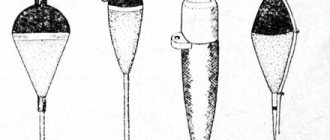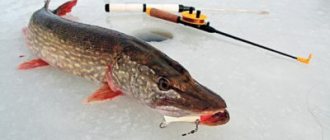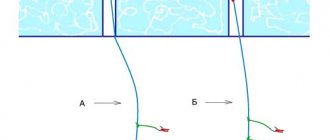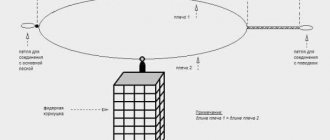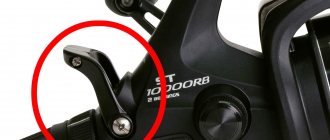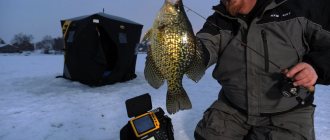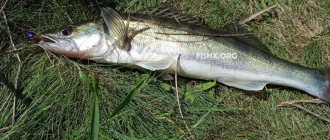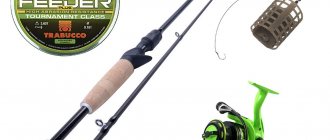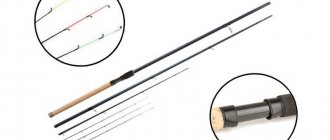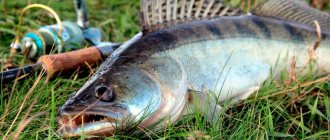What is a feeder rod and how is it used?
Translated from English, feeder means “feeding trough”, “to feed”. That is, a feeder rod is nothing more than a fishing rod for feeding fish. The feeder differs from conventional forms in its removable tip (signaling device) and the number of rings. And also the close location of the feeder and hook. The design allows you to make long, dynamic casts.
Feeder gear helps to fish the bottom layers with greater efficiency.
Feeder equipment
The line for the feeder can be either single-filament (mono-filament) or multi-filament (also known as braid or cord). The first is more elastic, it is good for catching large fish that boldly take the bait. It is more convenient to fish with such a fishing line. But with long casts, a weak bite on it may not be noticed. Here it is better to use braided wire - its sensitivity is higher. Of course, it has almost no stretch, and this creates strong overloads for the blank and brake. Therefore, many people complement the braided line with an insert (shock leader) made of monofilament, which absorbs powerful jerks.
At first, while you get used to the feeder, use a fishing line that is not too thin, 0.16-0.18 mm. Hooks, as usual, are determined by the size of the bait and prey. For the feeder, it is best to purchase hooks with the inscription “Feeder” on the package. They are curved a little differently and have a shorter fore-end.
By the way, do you know how “feeder” is translated from English? This is the “feeding trough, the breadwinner.” The feeder feeder usually has the form of a cage, which is open at two ends. Sometimes a plastic flap is placed on one of them to prevent the fertilizer from being washed out too quickly. But I would still advise not to do this. You can slow down the washout by using a more viscous, dense filler. For particularly valuable feeding (such as maggots), closed feeders with holes in the body are purchased. But, in general, you can do without them by making end caps in the cage.
In a standing pond, the feeder can be round, but for a flowing one, a cage is better - it will not be so easily carried away by the current. Moreover, the stronger it is, the greater the mass the feeder should have.
What types of feeders are there by design and their advantages?
According to experts, the difference between the plug and telescopic forms is small. Each angler chooses a feeder taking into account practicality and comfort. According to theory, the plug blank has no inertia of the knees when casting, but this difference is noticeable only at sports competitions. The wear resistance of telescopic rods has long been equal to that of plug rods. Also, the increased sensitivity of plug forms is compensated by a replaceable tip.
Expert advice
Forester Seva
Expert
Ask a Question
Try to purchase a feeder from a trusted fishing store, and also carefully check it for defects on site. Inspect the form for damage and the ring for chips and cracks. I do not recommend ordering delivery, but rather going to the store in person. Ideally with a friend who has experience in feeder fishing. It’s not possible to choose a universal option for all cases, but two feeders can cover almost all fishing conditions (fishing in still water and on rivers with a current).
Plug feeders
When choosing plug rods for feeder fishing, you can be sure that when catching a trophy, the blank will withstand the load. These rods are quite suitable for beginners and professional fishermen.
Advantages:
- The main difference between a plug and a telefeeder is the number of bends. Thanks to this, plug rods are much stronger than telescopic rods. Sometimes the number of elbows in the plugs reaches 5 pieces, but usually in feeder fishing rods with 2 are used. Modular (one-piece) models are also produced. Such forms have the greatest strength, but are very inconvenient during transportation.
- The plug weighs less than a telescopic fishing rod.
- Fishing is smoother due to the work of the whole body of the rod.
- Easy assembly.
- The sensitivity of the rod is higher.
Minuses:
- High price for purchase and repair.
- Not very convenient for hiking on fish.
- A tube or thick case is required for transportation.
Telescopic models
The choice of feeder rod often depends on the preferences of the fisherman. If during fishing there are long walks and frequent changes of place, then it is better to give preference to telescopic models.
Advantages:
- The compactness of the telescope allows you to carry the fishing rod in a backpack or hand.
- The price is usually lower than for plug forms, but greatly depends on the material of manufacture and the company.
- Repairing a telescopic fishing rod is cheaper. Usually the knee is replaced with a similar part.
Minuses:
- The strength of the rod is lower.
- The process of catching trophies requires caution and experience.
- Telescopic forms have reduced sensitivity, but this is compensated by a replaceable tip.
- The telescope weighs more than a plug rod.
It’s not entirely true to talk about which rod is better. Each fisherman chooses the option that meets his personal needs, but for the most part, experienced fishermen choose plug feeders.
Sensitivity of feeder tips and their classification
The sensitivity of the tips is a parameter that shows how much force needs to be applied to the tip of the tip so that it bends at an angle of 90 degrees. Measured in ounces, it ranges from ultra-thin tips that respond to even the slightest gust of wind, to nearly rigid 6-ounce tips.
Feeder rod tips are usually divided into three types according to the degree of rigidity (also known as sensitivity):
- Soft - for fishing in reservoirs with standing water or very weak currents.
- Medium - for fishing in medium currents or in still water in windy weather.
- Hard - for fishing in strong currents.
How to choose a feeder for a novice fisherman
Before buying a feeder, you need to clearly answer the question. What will this form be used for and under what conditions? You shouldn’t buy an expensive fishing rod for your first experience. Experts recommend starting your first casts with inexpensive fishing rods, and only then moving on to branded models. After the first fishing trips, a beginner will have certain requirements for the feeder and gear. Changing an expensive fishing rod if it doesn’t suit you at all will be more difficult.
When choosing a rod for feeder fishing, you need to take into account such points as the fishing location, the size of the gear, the type of gear, the type of fish, the number and distance of casts. Again, if the rod is used 1-2 times a year, then there is no point in buying an expensive blank. But if fishing trips happen every weekend, then buying an expensive fishing rod will be justified.
Main characteristics of a feeder rod
The main classification of feeder rods is divided into test (class), action, length, material. Selecting the appropriate form is not as difficult as it seems at first glance. Recently, manufacturers have stopped specifying the action, since it is less important when fishing than other characteristics.
The classification of the form is indicated by markings on the rod. All necessary parameters can be viewed directly in the store before purchasing. It is important not to forget about fishing conditions such as casting distance, presence of current, size of fish.
Read a review of the budget Inspiron feeder, which is popular among bottom fishing enthusiasts.
What should be the length of the rod
Usually the length of the rod is tied to the test. Most often, length is measured within a class. The optimal feeder length should be determined based on specific parameters that should be taken into account.
Selection conditions:
- Fisherman's height. Level of training.
- Casting distance.
- Type of fish. The weight of the future catch.
- Weight of gear (feeder).
- Conditions of the reservoir. Strong or weak currents, standing water, snags, steepness of the coastline, space for takeoff and swing, and other factors.
For beginners, it is better to opt for average parameters. The length of the feeder rod from 3.3 to 3.9 meters will allow you to fish in quite different conditions. With such dimensions, a beginner will not lose control of the bait and will confidently cast even over long distances.
For ultra-long casts, you can choose blanks with a length of 4 to 4.5 meters. These rods are suitable for fishing in fast currents. By placing the fishing rod vertically on the shore, you can reduce the length of the fishing line in the water. Some models have additional elbows. Thanks to this modification, you can get two completely different rod lengths. This will help expand the list of convenient fishing spots.
How to choose a feeder based on test and rod class
When selecting the feeder test parameter, you need to add the weight of the feeders and bait. Manufacturers usually indicate parameters below the upper limit, but it’s still better to be on the safe side. A small safety margin does not greatly affect the fishing process. An overloaded blank will throw the bait closer than necessary, and the tip may break off.
Classification:
- Ultralight (picker). Test of such sticks up to 30 gr. and the length is no more than 2.7 m. The fishing rods are designed to work with or without ultra-light feeders. The casting range of the feeder is from 10 to 30 m. It works well along the coastline and in conditions of increased vegetation. Sometimes used as a second number.
- Light feeder has a test of up to 60 g. The length does not exceed 3.6 m. It is considered a universal form for fishing at 30–50 meters. Some models allow you to successfully use heavier feeders on reservoirs with weak currents. Typically used for fishing in still water.
- Medium class has an upper weight limit of up to 100 grams. The casting distance with such forms is usually 50–60 meters. Experienced fishermen can put bait under the shore, but this requires constant training and a feel for the gear. It will be difficult for a beginner to work with this class at short distances. Suitable for all bodies of water.
- Heavy class allows you to work with weights up to 120 g. Perhaps the most versatile and widespread fishing rods. The large weight of the feeder allows you to make long casts and feed even in the current. The casting range can exceed 70–75 meters.
- Extra heavy feeder weight more than 120 g. Used by professionals for fishing in strong currents. Designed for casting heavy feeders. Not the best choice for beginners. Working with such forms requires a lot of practice.
Build fishing rods
The structure of the form is determined by the nature of bending under load. This characteristic was no longer taken into account and identified as a separate parameter, as manufacturers began to produce models adapted to the class of fishing rods.
Characteristics:
- Super fast build. The body of the fishing rod begins its bending from the top.
- Fast (fast). The rod begins to bend in the upper third.
- Medium (semi-parabolic). The bend starts in the middle of the blank.
- Slow tuning is characterized by a smooth curve of the entire body.
You can determine the system yourself with a simple test. To do this, the tip is secured with fishing line or someone is asked to hold the tip in a stable position. In this case, the fisherman must slowly lift the body of the fishing rod, holding it by the handle. Having determined in what place and at what speed the form is bent, you can calculate its structure.
Experienced fishermen use fishing rods with fast action. Slow forms are suitable for beginners. Thanks to their features, slow-action fishing rods forgive most mistakes when fishing. They also easily compensate for excess load.
Form material
When choosing a feeder fishing rod, you should pay special attention to the material. This parameter affects price, weight, strength, sensitivity, flexibility and service life. All other things being equal, it is better for beginners to opt for heavier models.
Pros and cons of materials:
- Fiberglass is an inexpensive material. Has good flexibility and strength. A fiberglass fishing rod will last a long time. Does not require careful treatment or specific maintenance. Cons: reduced sensitivity and rather heavy weight.
- Carbon fiber (carbon). The undeniable advantages of such forms are lightness and sensitivity. Allows you to catch very cautious fish in sluggish biting conditions. Cons: fragility and high price. Carbon rods must be handled very carefully. Such forms may not survive being thrown onto rocks, overloading gear, or improper transportation. Suitable for careful fishermen.
- Composite materials combine fiberglass and carbon in one fishing rod. Thanks to this, the rod has average parameters and characteristics. The advantages of these models are affordable price, durability, good sensitivity, and lightness.
Quivertypes and their role in fishing
Quivertip signaling tips are sold complete with a fishing rod. Elasticity varies by color. Using the color scheme, the weight of the feeder with bait is determined. It is better to have a spare set for different conditions. The elasticity and rigidity of the tip starts with white (light weight), then goes to green (medium weight) and ends with red (heavy weight of the feeder).
Quivertips on expensive feeder rods often differ not by color, but by weight in ounces. Sometimes such markings make you think that the tip has its own test. This is a misconception.
Often the tip is not involved in casting and retrieving. Typically, these numbers and colors are used to determine the weight of the feeder and bite sensitivity. If you load the rod above the upper threshold, the tip may break when casting. It's rare, but it happens. Most often, breakage occurs due to the line overlapping the tulip. Vershinki are consumables; even experienced feeders prefer to buy alarms with a reserve in case of breakdowns.
Comfortable handle
The handle should be made of non-slip material. Typically, feeder fishing rods are equipped with handles made of balsa wood or thick, corrugated rubber. It is important to pay attention to the grip. The handle should fit comfortably in the palm of your hand and not turn when casting.
The reel is attached to the handle or slightly above. It is important that the mount allows the installation of different models. The versatility of the fastener will help you not to bother with choosing and adjusting the reel to a specific type of blank.
Passing rings
During the inspection of the fishing rod, you need to check a number of access rings. The correct location is strictly on the same line relative to the axis of the handle. To check, you can place the assembled form on a flat surface and look into the first ring. The center of all rings must be strictly one after another. Any deviations reduce the service life and affect the quality of casting.
The rings should not turn or wobble. The inner surface of good passage rings is made of high-quality material. Chips or unevenness in the inner diameter will lead to the shooting of the feeder and fraying of the fishing line.
Weight
Statistically, the less weight a feeder rod has, the easier it is to work with. But you cannot reduce weight at the expense of other more important parameters. When choosing lighter models, one should not forget about the test, length and other important characteristics. It would be better if the form weighed a little more, but would be more durable.
What are feeder rods?
The feeder structure consists of:
- blank (fishing rod body);
- handles;
- spool holder (reel holder);
- plug connections;
- pass rings;
- quivertypes.
Each fishing rod comes with 2-3 quivertips (replaceable tips), with different test, for fishing in a variety of conditions. Since the stiffness of the tips is different, before assembling the rod, the angler chooses the quivertype that will be more sensitive for a given body of water.
If there is a current, it is better to put a rigid tip, which, after casting the tackle, will take the correct position and signal a bite. In the absence of a current, a less rigid quiver tip is installed, which is capable of “recognizing” the most delicate bites of small fish.
Usually the tops are designated by different colors:
- yellow;
- red;
- green.
According to generally accepted rules, the green tip is the softest, and the red tip is the hardest.
The form or body of the feeder is the main part and for its manufacture the following are used:
- carbon fiber (carbon);
- composite materials;
- fiberglass.
Form
The reliability and strength of the fishing rod, as well as its weight, depend on the quality of the manufacturing material, because, say, carbon is lighter and stronger than fiberglass, but it also costs more. Considering that after throwing the feeder into the water, the rod is installed on stands, its weight may not seem to be the most important characteristic, since you do not have to constantly hold the rod in your hands.
But catching small fish on a feeder is fast, requiring frequent recasts, and if you come fishing not to pump up your muscles, but to have fun, then the weight of the form matters. Carbon fiber feeders are the strongest, but this does not mean that fiberglass or composite rods will break after the first casts.
Each form is characterized by test indicators that indicate what weight feeders should be used with it. At the same time, the cost of carbon is higher and it is not always necessary to spend money on an expensive feeder, especially if you plan to fish at short distances with light weight feeders. The fisherman chooses a feeder based on the price-quality ratio, and everyone has their own preferences.
Lever
The angler is in direct contact with the handle of the rod and it should be comfortable so that the feeder fits well in the hand.
For the manufacture of handles the following is used:
- cork;
- soft EVA material.
Cork is more durable, and EVA is more pleasant to the touch and cheaper. Both materials are quickly washed off from dirt, and this is also an important point. The handles are spaced and solid, and their length depends on the length of the feeder. The longer the feeder handle, the greater the leverage will be during casting, so long-range feeders are equipped with long handles.
Passing rings
Not all feeder fishing enthusiasts understand how important rod guides are and what they should be like. A larger number of rings than on other types of rods is an undoubted advantage of the feeder, increasing its astringent properties when playing caught fish.
The material of manufacture, design and number of rings are especially important when fishing with braided fishing lines, which exert a serious load when casting onto the ring inserts. The characteristics of any feeder must indicate the number of rings and the material of the inserts, although, unfortunately, there is no such marking on the forms.
But every reputable seller should have equipment catalogs that contain all the data, including those related to rings. For fishing with a line, you should buy feeders with silicon-coated metal-ceramic inserts (SIC).
Expensive fishing rods are necessarily equipped with rings with inserts, but in any case you need to make sure that they are there. The greater the number of rings on the form, the better, because they help distribute the load evenly. The type of fastening of the rings also deserves attention and it is better to have three legs rather than two.
Important! When buying a feeder, make sure that there are no burrs, cracks or chips inside the rings.
Reel seats
Feeder rods are equipped with reel seats for attaching a reel.
They are:
- open rear screws;
- front screw.
Open rear screw clamps are equipped with a nut, with which the coil is firmly fixed in the stock. The front screw reel seat is essentially a decorative cover for the screw clamp. The front clamp holds the reel more securely and looks more aesthetically pleasing than the rear one. But its price is also higher, and for a long time, expensive feeder models were equipped with clamps for coils of this design.
Now the situation has changed and such clamps are also installed on budget fishing rods, but this affects their cost. The open rear lock sometimes unwinds in the fisherman’s hands, and at the most inopportune moment, and its reliability is still lower. The main task of the reel seat is to securely fix the reel, and other characteristics do not play a decisive role.
Important! When buying a feeder, check whether the reel seat fits the reel you plan to use with it.
You can find out more detailed information about quivertypes in a separate article on our website.
Choosing a feeder rod based on the fishing location
For different fishing conditions, feeder rods with different parameters are needed. Experienced fishermen advise beginners to choose conditionally universal models. But if the fishing spot remains unchanged, then it is better to choose the form more carefully.
Parameters for different conditions:
- For fishing on small rivers (regardless of the current), fishing rods from 3.3 to 3.6 m are suitable. Class (test) up to 70–80 g. The action, if specified separately, is fast or medium.
- Feeder rods for a river with a wide water area should be from 3.6 to 4.2 m. The test is at least 80–150 g. It is better to choose a quick build.
- If you plan to fish on a lake or pond, you need to use sticks with a length of 3.3 to 3.9 m with a dough of 30 to 100 g. Build fast or medium.
- Pickers are suitable for small lakes and ponds. The length of the rod is from 2.7 to 3 meters. Test from 20 to 30 gr.
- For fishing from the side of a boat, use fishing rods from 2.5 to 3 meters. Test from 20 to 60 gr. Build fast or medium.
In addition to the described parameters, fishing may also depend on weather conditions. Rain, sun, wind and fog may have an effect.
Read the review of the Volzhanka River Monster feeder, which is perfect for river fishing conditions.
Review of the best models and their estimated cost
Having examined several popular models, we can draw a conclusion about them. The best models have gained popularity among fishermen for good reason.
- Shimano Beast Master Feeder model. Its length is 3.3 meters, this feeder is ideal for fishing in still water. Equipped with 15 rings, test 50 grams. The estimated cost will be about 10,000 rubles.
- Model Daiwa Vulcan X Leger. The rod is made of graphite, very durable. Test 60 grams, length 3.66 meters. The cost is very pleasing to many fishing enthusiasts. It is about 8500 rubles.
- Model Nautilus Vegan Feeder NVF. This rod is designed for medium and long distance fishing. There are 15 rings in total. The cost of a 4.1 meter long model with a dough weight of up to 80 grams will be approximately 9,800 rubles.
- The Team Salmo TOURNAMENT 100 model is produced in Latvia and is quite expensive. The quality of the product corresponds to the price. Performance characteristics are high. Length is 3.9 meters, test 100 grams. The rings of the model are lightweight. Excellent depreciation of the form. The cost of the model, including the Fuji reel seat, is 20,500 rubles.
In general, there are a huge number of feeder models on the market. The consumer has an excellent choice and very varied prices. A feeder is an excellent fishing rod, when choosing which you should not trust the seller or your fisherman friend. There are very specific parameters that will determine for a fisherman not only a high-quality model, but also one that is suitable for the required fishing conditions.
Buy an expensive or budget-priced first feeder
An expensive purchase should only be made when you are confident in the right choice. For your first fishing trips and gaining experience, a lightweight, inexpensive feeder is best suited (read the guide on feeder fishing here). The ratio, price - quality is not always justified. Especially when it comes to test trips, when there is no confidence that the feeder will be used constantly.
Manufacturers of branded models offer a wide range of feeders to suit every taste and budget. If your budget allows, then you can settle on some universal model and learn to work with it. Not all fishermen can afford to buy expensive forms and most often purchase budget models.
It’s not difficult for a beginner to choose a budget feeder. The models may be far from perfect, but they perform the basic functions. When there is nothing to compare with, there is no point in spending more. After experience and understanding comes, you can choose a more expensive fishing rod.
Operating principle and classification
What is a feeder in the electric power industry? It is often confused with a distributor, because it also transfers energy from a generating station (or substation) to points of electricity consumption. However, the feeder does not perform intermediate control, so the current values remain the same on both the sending and receiving sides.
Depending on operating conditions, feeders are divided into the following groups:
- Industrial;
- For use in agriculture;
- Household (lighting).
In the latter cases, the line is designed for a voltage of 220 V (for other types - 220 and 380 V).
The sequence of operation of the feeder is determined by its purpose. The feeder line is part of the electrical distribution network. The electrical circuit in a building that transfers energy from a transformer or other similar device to a distribution panel is shown in Figure 1. Different loads are connected to buses to supply different loads: power and/or lighting.
Distribution feeder conductors exit the circuit breaker (or substation circuit recloser) through underground cables called output cables. Thus, the feeder in electrical engineering is part of the energy distribution system from primary devices to secondary devices. As follows from Figure 1, after energy is transmitted through the line, it reaches the substation, where the network voltage can decrease, depending on the power and the number of consumers.
Is it worth buying a used fishing rod?
It is worth remembering that used goods are very different from each other. You can purchase an excellent model at a low price that has hardly been used. And you can also run into a fishing rod after long use with internal defects that will not last long.
In any case, when buying a feeder you need to stock up on tips. These parts are most susceptible to fractures. It is also important to pay attention to the rings. The presence of chips and cracks in the inner circles will ruin any fishing. The fishing line or cord will constantly fray.
The main thing is to approach the purchase carefully and try not to miss important details. You can invite an expert fisherman to help you make a choice and inspect the fishing rod before purchasing.
